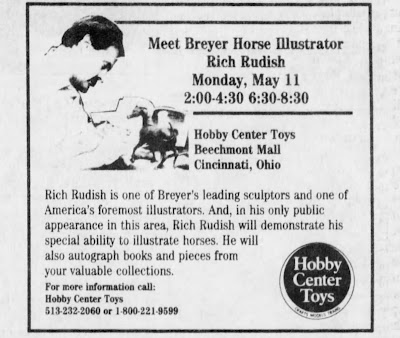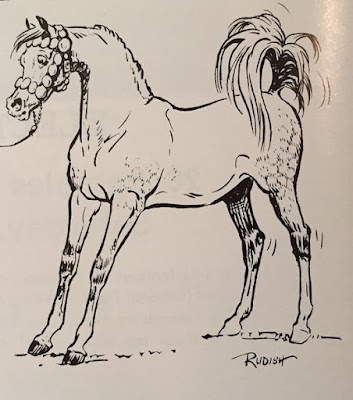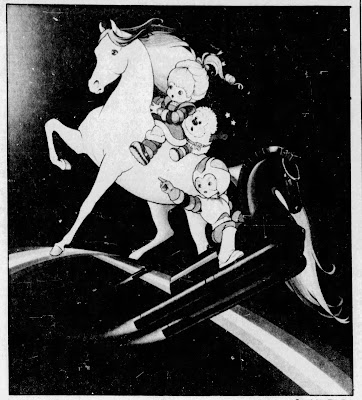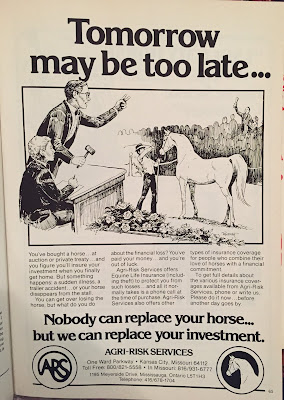This is the story of The Horse With the Proud Tail.
Every so often a piece of a horse's history will find its way to me, demanding to be told, reminding us of just how important the horse was to the humans who loved him. That happened to me again today, when my Horse Radar went off as I drove towards an antique mall.
When I went inside, I quickly spotted a very special original painting. The first thing I noticed about it was the horse's brilliant chestnut color with white markings, sparkling eyes, and flying tail. He looked like an Arabian.
 |
The artist was Rich Rudish. Sold.
But I wondered: Was this a portrait of a real horse? And if so, how could I find out? There were no other identifying marks on the painting, front or back, so I looked for clues from other sources.
%20wm.jpg) |
Rudish was born in 1941; the painting is dated 1965. So he was only 24 when he painted it. A Kansas City newspaper article said that Rudish joined Hallmark Cards as an illustrator in 1964, so we know he was active as an artist as a young adult.
With those dates in mind, I started looking for connections between Rudish and Arabian horses. Newspaper articles told me that Rudish rode and trained Arabians in the Midwest in the 1960s. Later, he would serve as an officer in his area's Arabian horse club and as a judge of Arabian classes at horse shows.
After a few minutes' searching online I came up with the name of a horse ridden in a show by Rudish: the chestnut Arabian gelding Zartai, foaled in 1954.
 |
| The Clinton, Missouri Eye newspaper, July 19, 1966. |
I kept looking, and found a photo of Zartai from 1967, again ridden by Rich Rudish. Zartai belonged to Triangle "C" Arabians (the Campbell family), and had won a Top Ten Award at the Arabian US Nationals.
 |
| Belton, Missouri Star-Herald, August 24, 1967 |
The photos are not great quality, but we can see that Zartai had an oddly shaped blaze on his face...
So does the horse in the painting.
%20wm.jpg) |
So does the horse in the painting!
So I think it's highly probable that the horse in the painting is indeed Zartai.
A search of the Arabian Horse DataSource shows that Zartai, foaled in 1954, was sired by Ibn Nusi; his dam was Zatai.
Another of Zartai's ancestors was the great and beautiful mare Mahroussa. Here's a head study photo by Carl Raswan:
 |
Here are two more examples of Rudish's greeting card designs with horses:
 |
| A Hallmark card |
 |
| An Ambassador card |
Rudish served as Director, Art Director, and in the Animation Department on several films in the 1980s, including many of the "Rainbow Brite" animated movies.
Among horse lovers, he is well known as an illustrator of horse books such as Marguerite Henry's Our First Pony, and the 1975 edition of her book The Little Fellow.
 |
Here are some horse stickers Rich Rudish designed for Hallmark.
Rudish's art appeared on coffee mugs and playing cards. He also illustrated a pop-up book called Dancer and a calendar for Hallmark, as well as a book on the Old West.
 |
 |
Rudish illustrated Arnold R. Rojas' book These Were the Vaqueros.
 |
He also designed model horses for Breyer, including "Sham" and "Lady Roxana," and also for Enesco.
 |
| Cincinnati Enquirer, May 10, 1987 |
Starting in the 1970s, it was common to see illustrations by Rich Rudish in Arabian horse magazines and horse show programs. You can see his style evolving over the years.
 |
 |
| Rudish's sense of humor is obvious in this illustration in an advertisement. |
 |
Rudish's stylized color ads depicting real Arabians are unmistakable.
 |
| *Tamarlane and Taktika |
 |
| *Padron and Bint Padron |
Rich Rudish died in Glendale, California in 1989, which may partially explain how the painting of Zartai made its way from Missouri, where he lived for so long, to an antique mall in Ventura County, California.
Where the painting was in the meantime, we may never know. Perhaps Rudish himself saved it, sold it, or gave it to someone else.
 |
| Belton, MO Star-Herald, May 25, 1989 |
Because it lived for who-knows-how-long at an antique mall surrounded by thousands of other used decorative objects, the painting of "Hoppi" could have ended up in the home of someone who had no idea of its story, or (God forbid) it could have been damaged or painted over. Instead, I was drawn to it like a magnet -- which I can't explain.
However this example of Rudish's early art came to me, I like to think that somehow its story needed to be told, if only to remind us again just how important horses, our love for them, and our memories of them, are to us.


%20wm.jpg)





%20wm.jpg)



















%20wm.jpg)


WONDERFUL story! Thank you for sharing! And thank you for finding that painting and giving it a great home!
ReplyDeleteThank you for doing the detective work and letting us all know the story behind the remarkable painting!!!
ReplyDeleteDid you notice that Gulastra's photo and the Elizabeth Bell print don't match? The photo clearly shows him as having two white legs, while the drawing shows three. Judy Barbour
ReplyDeleteYes, and thanks for the reminder! It is odd. I updated the post to reflect the fact that you pointed out the discrepancy in the markings.
DeleteFascinating. Thank you for your work.
ReplyDelete